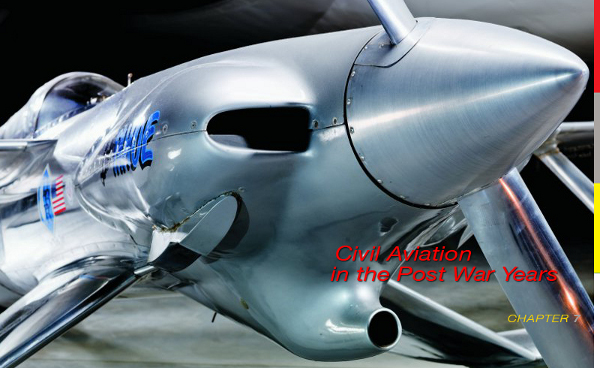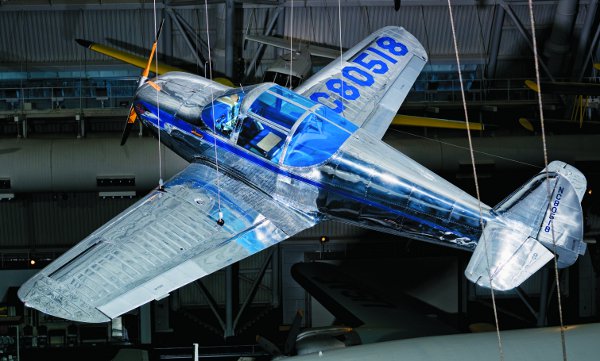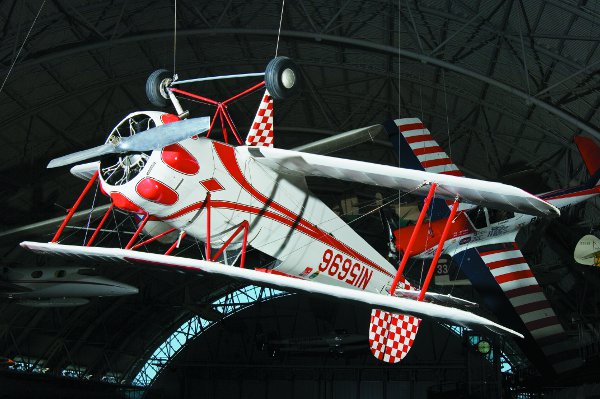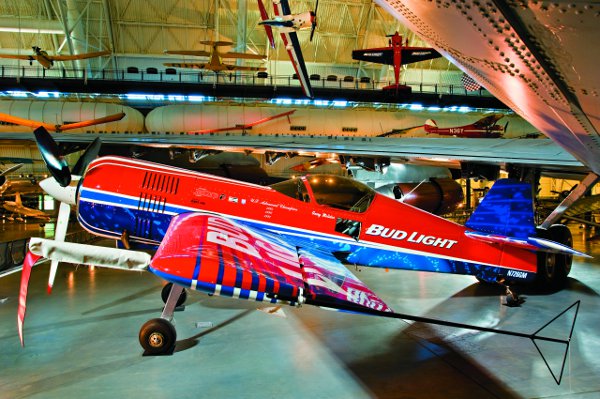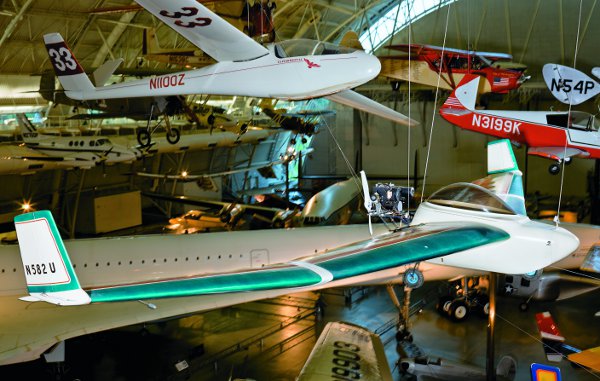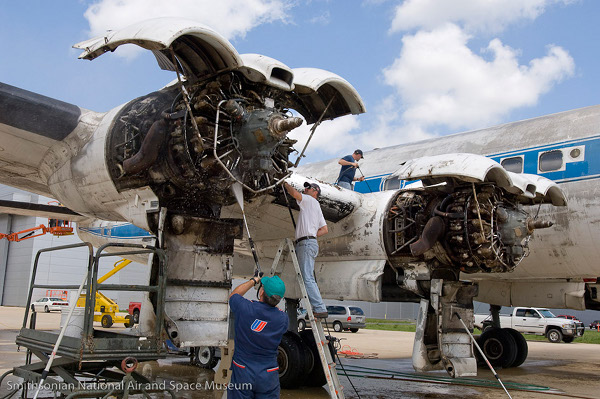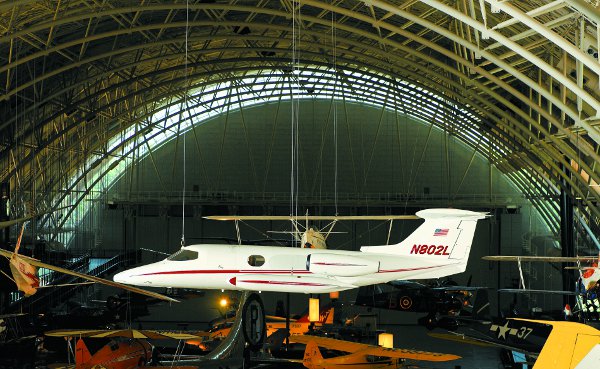
Betty Skelton’s Pitts Special S-1C Little Stinker now greets visitors as they enter the Steven F. Udvar-Hazy Center.
Flush in the immediate glow of victory, America quickly retooled its economy to take advantage of its newly found economic power. Within a year of the end of the Second World War, the nation’s economy began to expand rapidly, as years of pent-up demand for consumer goods and enforced savings were unleashed in a consumer-driven economic boom. Returning veterans were granted unprecedented privileges through the GI Bill of Rights that gave millions of citizens access to low-cost home loans and unheard-of educational opportunities. This prompted a massive building boom especially in newly-created suburbia and flooded the nation’s colleges and universities with new students. America entered a period of prosperity that would last for more than two decades.
As consumer spending rose dramatically, many leaders in the aviation industry sought to capitalize on this emerging market. With the cancellation of billions of dollars worth of war contracts, the aircraft manufacturers were banking on the expansion of the general aviation market to offset these losses. Thousands of veterans who had learned to fly during the war were expected to continue in aviation. Business leaders hoped that these former GIs would spend their money on new private aircraft that were beginning to arrive on the market. These sanguine hopes spurred a large expansion of the civil aviation industry, but the industry’s hopes were soon dashed. Most former military pilots just wanted to get back to their peacetime careers and build a home for their new families. An aircraft for their personal use was out of the question.
After this early struggle, however, the aircraft manufacturers were able to carve out a comfortable market for their general aircraft. By the 1950s, general aviation was expanding as the nation’s prosperity during the Eisenhower years produced an unprecedented amount of discretionary income. Some of this was spent on aircraft, and not just automobiles and televisions. New uses for these aircraft also increased their utility. Originally built for personal transportation, general aircraft were found to be ideally suited for a variety of tasks from aerial taxi service to crop dusting to survey work. Air racing returned—though on a smaller scale, sailplanes increased in popularity, and businesses took a renewed interest in finding faster ways to transport executives quickly around the country.
By the 1970s, with the cost of personal aircraft skyrocketing amidst inflation and lawsuits, the low-cost homebuilt aircraft industry found a ready market, and NASM’s National Aeronautical Collection preserves many examples of these important aircraft.
Following the conclusion of the Second World War, manufacturers such as Piper, Beechcraft, and Cessna, among others, returned to the production of civil aircraft. The trend toward more versatile, all-metal design begun in the late 1930s continued with a host of new and improved aircraft that quickly reached the market. Concurrent with the rising interest in general aviation, many sought to publicize the capabilities of these new aircraft through a series of record-setting flights. Others just came and went with the changing economy.
In 1930, in Riverdale, Maryland, a quiet suburb of Washington, D.C., the small Engineering and Research Corporation (ERCO) was created by Henry Berliner to manufacture precision tooling machines for aircraft companies. ERCO made controllable-pitch propellers, aluminum sheet formers, and propeller profilers. In fact, all U.S. propellers built during World War II were ground on ERCO profilers.
Built in Riverdale, Maryland, by the Engineering and Research Corporation, or ERCO, this Ercoupe is seen flying over Washington, DC. An earlier version of this aircraft was the first light airplane to be fitted with tricycle landing gear.
In 1937, Berliner decided to enter the light aircraft business and hired noted National Advisory Committee for Aeronautics (NACA) engineer Fred Weick as chief designer. Weick had already built his W-1 and W-1A high-wing pusher for a safe airplane contest sponsored by the U.S. Commerce Department. Berliner decided that a more conventional aluminum low-wing tractor design would be more marketable, so the two combined their considerable expertise and produced a unique two-seat, low-wing monoplane they named the Ercoupe. The first version was the ERCO 310 and featured a twin tail and a tricycle landing gear, a first for a light airplane. This evolved into the production 415-C that was powered by a 65-horsepower Continental A-65 “flat four” engine.
What made the Ercoupe unique was its original control system, which eliminated the need for rudder pedals. The rudders were linked directly to the full-length ailerons, thus ensuring well-coordinated turns. The careful design of the wings and the limited travel of the elevators ensured that the Ercoupe was immune to stalls and spins. Training time for a new pilot was half that for a conventional aircraft, making the Ercoupe an immediate success with hundreds of casual flyers. However, as it was fitted with a two-control system, rather than three, which featured a conventional control wheel but no rudder pedals, Ercoupe pilots received a special license from the Civilian Aviation Authority restricting them to this single aircraft type. Eventually ERCO relented and offered Ercoupes with a traditional three-control system as well. Undaunted, Erco produced 112 Ercoupes before World War II interrupted production and the company shifted its efforts to the war industry.
After the war, ERCO resumed production of the Ercoupe to fill the thousands of orders that were expected to come from the returning servicemen. The Ercoupe 415-D had a more powerful 75-horsepower Continental engine. Other versions soon followed. For his pioneering work in building a safe, popular light aircraft, Fred Weick received the Fawcett Aviation Award. The Ercoupe developed a loyal following but even its devotion was not enough to overcome slow sales. By the outbreak of the Korean War, ERCO had withdrawn from the light aircraft market and returned to its more lucrative tooling business. The rights to the Ercoupe were sold to Forney Manufacturing of Fort Collins, Colorado, which built the aircraft until 1959. After a succession of owners, the Mooney Aircraft Corporation, the last builder of Fred Weick’s innovative design, finally ended production of this clever little aircraft in 1970.
NASM is fortunate in owning the first production Ercoupe 415-C ever built. It was completed in October 1939 and received its airworthiness certificate on April 2, 1940. The Brinkerhoff Flying Service of College Park, Maryland, first purchased this aircraft in January 1941 for use as a trainer. After a succession of owners, Mr. Robert F. Whipperman of California acquired the 415-C in 1946. He kept it until 1979 when he donated it to NASM.
In New Castle, Delaware, the Bellanca Aircraft Company weathered World War II as a subcontractor to Fairchild. It too had visions of a large postwar market for light aircraft and produced a series of attractive designs. NASM’s version, a Bellanca 14-13-2 Cruisair Senior, is a four-place cabin monoplane fitted with a single 150-horsepower Franklin engine. The fine aerodynamics of the Cruisair gave it a top speed of 169 miles per hour—quite remarkable for its horsepower. The aircraft debuted at the National Air Show in Cleveland, Ohio, in November 1946 and was a hit. Assuming that the postwar boom would continue, Bellanca made plans to fill the reported 1,300 orders. Unfortunately, most of these failed to materialize and Bellanca ceased Cruisair production 1949.
Another beautiful but short-lived aircraft was produced just after World War II. The Globe Swift is recognized as a classic post-World War II general aviation aircraft design due to its beauty and sporty flying characteristics. It was also the only multiseat, complex aircraft under 100 horsepower in the normal category (not experimental) in the United States. The all-metal Globe Swift was a major advance in performance and complexity over the more prevalent and minimally improved pre-war tube, wood, and fabric designs still being produced. With its sleek lines and retractable landing gear, this aircraft was an ideal, economical civilian counterpart to the fighter aircraft that many pilots flew during World War II. Some consider the handling and performance of the higher-powered Swift GC-1B version to be somewhat reminiscent of a smaller version of the U.S. Army Air Force’s P-40 fighter of the early 1940s.
The Globe Swift had its beginnings in Fort Worth, Texas, in 1940, when R.S. “Pop” Johnson built the first Swift as a homebuilt airplane with a tube-and-fabric fuselage and Duraloid wings and tail surfaces. Toward the end of the war additional wood-metal prototype GC-1s were built, although the end design was the all-metal Swift GC-1A. The first prototype GC-1A flew in January 1945 and the first production model was completed in November of that year. While orders for the GC-1A numbered in the thousands, only a total of 408 GC-1A airplanes were built before the higher-powered GC-1B was put into production. The majority of Swift’s production was the GC-1B model, of which 833 were built in just over six months in 1947. Globe built 504 and 329 were built by the Texas Engineering & Manufacturing Company (TEMCO) as a sub-contractor when Globe initially became overwhelmed with orders. However, the post-World War II general-aviation production glut soon caught up with Globe and GC-1B production was halted. Globe Aircraft filed for bankruptcy and TEMCO took it over in August 1947. TEMCO continued to build and modify the Swift until 1951.
Ludlow “Pete” King bought NASM’s Swift in 1975 and restored it to near-original condition. He donated it in 2005; it is now suspended, shimmering in its natural aluminum finish, from the ceiling of the Udvar-Hazy Center.
Known affectionately as the “Texas Messerschmitt,” the tiny Mooney M-18C Mite was developed from a series of radio-controlled drones built by the defunct Culver Company. In 1946, two former Culver executives formed the Mooney Aircraft Company to build a single-seat low-wing monoplane equipped with a tricycle landing gear and powered by a 25-horsepower Crosley Cobra automobile engine. Weighing only 850 pounds fully loaded, the little Mite could carry a useful load of 330 pounds when fitted with a larger Continental A-65 engine and it gained a small though enthusiastic following. Easy to fly, and with a low list price, the Mite sold reasonably well until the demand for larger, better-equipped aircraft forced Mooney to end production after 355 were built. NASM’s Mite is the first one built and was donated by Mr. Johan Kala.
The ubiquitous Continental A-65 engine was clearly a popular engine in the postwar generation of aircraft. In 1949, the Helio Aircraft Corporation of Norwood, Massachusetts, fitted an A-65 to its first aircraft design. Based on a highly modified Piper Vagabond, the Helio No. 1 was America’s first original short takeoff and landing (STOL) design and served as the prototype for the successful Helio Courier. The No. 1 was equipped with automatic leading-edge slats as well as flaps and slots. A unique spoiler-like device improved the airflow through the slats and enhanced the efficiency of the wing. The aircraft could take off and land within 500 feet while clearing a 50-foot barrier. Its controls were effective at speeds as low as 28 miles per hour. The Helio Company donated the aircraft to NASM in 1963.
Immediately after the conclusion of the Second World War, William Piper retooled his company to produce new versions of the light airplanes that had made the Piper Aircraft Company famous. The popular Cub had gone to war as the L-4 Grasshopper, serving with distinction as a spotter and liaison aircraft. In 1945, under the direction of C. Jamoneau, Piper produced an improved version of its J-5 Cruiser to be known as the PA-12 Super Cruiser. This new three-seat aircraft featured a 115-horsepower Lycoming flat-four engine. After its first flight in December 1945, the Super Cruiser was immediately successful and demonstrated its versatility in a variety of roles.


The aptly named Mooney M-18C Mite was a tiny single-seat aircraft developed from radio-controlled drones.
NASM is fortunate in preserving a very special PA-12. In 1947, U.S. Air Force reserve officers Maj. Clifford V. Evans and Maj. George Truman persuaded Piper and Lycoming to provide them with two PA-12s and the necessary support for a proposed around-the-world flight. Two used Super Cruisers were acquired and modified with extra fuel tanks, instruments, radios, and metal propellers. So equipped, the majors took off from Teterboro Airport, New Jersey, on August 9, 1947. With Truman in the City of Washington and Evans in the City of Angels, the two pilots circumnavigated the globe in four months, dodging bad weather in an otherwise uneventful flight. Upon their return on December 10, Truman and Evans had completed the first around-the-world flight for an aircraft with less than 100 horsepower, having covered 22,500 miles during their journey. Two years later, Mr. Piper presented the City of Washington to the Museum.
Piper had an enviable reputation as a manufacturer of excellent single-engined aircraft for private owners. During the 1950s, this market expanded and wealthier buyers became more interested in acquiring larger, more powerful aircraft with the added safety of an additional engine. As a result, in 1953 Piper introduced its first twin-engine cabin monoplane, the PA-23 Apache, which set a standard for the entire industry. Many were flown for personal use. Many more saw service as business aircraft or were utilized by third-level commuter airlines, where they enjoyed a reputation for efficiency and delightful handling characteristics. Incidentally, the Apache was also the first in a long line of Piper aircraft to be named after American Indian tribes.
The new four-seat Apache flew with two 150-horsepower Lycoming O-320 engines. Later versions were fitted with 160- or 235-horsepower engines with room for an additional passenger. By the time production ended in 1966, some 2,166 PA-23s had been sold. Many still fly today. William Davenport of Richmond, Virginia, owned the 13th PA-23 built. In 1990, after 32 years of ownership, he donated it to NASM.
At the Beech Aircraft Corporation in Wichita, Kansas, a new revolutionary light cabin monoplane made its debut late in 1945. Known as the Bonanza, this beautiful all-metal low-wing monoplane immediately caught the public’s attention with its graceful lines and unique V-shaped tail. The tail design was based on the ideas of Polish aircraft designer George Rudlicki, who determined that the “butterfly” shape weighed 35 percent less than a conventional cruciform tail and had lower drag. Intrigued by the enhanced performance offered by this design, Beech engineers extensively tested this configuration on an AT-10—the military trainer version of the Beech 18. Following successful trials, the V-tail was selected for the new Bonanza.
As with most of Beechcraft’s products, the Bonanza catered to the upper end of its market with its high quality, good performance, innovative design, and commensurate price. In fact, the Bonanza was built 15 percent stronger than conventional light aircraft so that it could be certificated as a utility aircraft. Intended to replace the Beech 17 as a luxury four-seat business and personal transport, Bonanza production began in 1947. Thirty years later more than 10,000 Bonanzas had been produced in numerous variations.
NASM’s Bonanza is an especially rare aircraft. Donated to the Museum by Beech in 1975, it was just the fourth one built and was flown on two historic flights. First, on January 12, 1949, Capt. William P. Odom set two distance records, first by flying from Hawaii to Oakland, a distance of 2,409 miles, in his aptly named Waikiki Beech. Two months later, from March 6th to March 8th, Captain Odom outdid himself by flying from Honolulu to Teterboro, New Jersey, some 5,273 miles at an average speed of 146 miles per hour. The aircraft was fitted with an extra 126-gallon fuel tank in the fuselage and a 62-gallon fuel tank on each wing tip. The Waikiki Beech was given to the Museum after the flight but in 1951 Beech reacquired it for another special flight.
Illinois congressional Rep. Peter F. Mack, Jr., borrowed the Bonanza for a proposed around-the-world flight. With the support of Beechcraft, Representative Mack left his home district of Springfield in the rechristened Friendship Flame, touring the globe and visiting 45 cities in 35 countries before returning to Wichita, Kansas, on April 19, 1952. The aircraft covered 33,000 miles in 113 days before it was returned to the Museum. In 1975, Beechcraft graciously refurbished this special Bonanza with the Waikiki Beech markings on the left fuselage and the Friendship Flame markings on the right.
NASM’s Beech 35 Bonanza Waikiki Beach set a light-aircraft distance record in 1949. Combining quality, strength, and excellent performance, the V-tailed Bonanza entered production in 1947. Thirty years later, more than 10,000 Bonanzas had been built.
In 1959, Beech Aircraft introduced the Model 65 Queen Air to fill the gap between the six-seat twin-Bonanza, a derivative of the single-engine Bonanza introduced in 1947, and the Super 18, a deluxe version of the classic Beech 18. The Queen Air featured the low-wing, all-metal, tricycle design typical of Beech’s post-war aircraft, carried seven to nine passengers, and featured two horizontally-opposed 340-horsepower Lycoming engines. Subsequent improvements included a swept tail and a pressurized fuselage, but when turboprop engines were added it was redesignated the King Air 90.
In August 1963, Beech Aircraft announced the King Air as an aircraft design meeting the requirements of executive and corporate business travel for six to nine passengers, using turboprop engines to bridge the gap between piston-power and jet aircraft. The first King Air, powered by Pratt & Whitney Canada PT6A-6 engines, flew on January 20, 1964, with deliveries beginning in late 1964. After the King Air’s initial success, Beech concentrated on continuous upgrades to appeal to a range of executive and corporate needs. Sophisticated electronics packages, increased cabin space, and finer interior amenities in subsequent versions provided comfortable working and transport environments for business travelers.
The Museum’s aircraft, LJ-34, is an early model with both the Queen Air and King Air designations, meaning it was a Queen Air 88 design upgraded with P&W Canada PT6A-6 engines. This aircraft had several owners before it was reacquired by the Raytheon Company’s Beech Aircraft Corporation and donated to the Museum in 1998.
A long-time competitor to Piper and Beech, the Cessna Aircraft Company of Wichita, Kansas, also emerged from the Second World War with numerous new products for the general aviation market. By late 1945, Cessna already had two products available. The Model 190 and 195 were large all-metal, fully-cantilevered, high-wing monoplanes equipped with a large Jacobs or Continental radial engine. While sales were steady, Cessna had already realized the need for a smaller, less-expensive aircraft to satisfy the demand in the expected coming postwar market boom. The result was the metal, two-seat Cessna 140 featuring a strut-braced wing that was partially covered in fabric and a small, air-cooled, four-cylinder, 75-horsepower Continental engine. It was also fitted with the spring-steel landing gear pioneered by Steve Wittman, which was to become a Cessna trademark. Sales of this attractive light aircraft were brisk. A stripped version known as the 120 also met with success, as did later improvements.
Piloting her Cessna 180 Spirit of Columbus in 1964, Geraldine Mock became the first woman to fly around the world.
Cessna realized, however, that the market required a four-seat aircraft to satisfy the demand from businessmen and private pilots who wished to fly their friends and families. In 1947, Cessna produced its Model 170 based on the 140 but with seating for four and a more powerful 145-horsepower, six-cylinder Continental C-145. By 1949, the Model 170 evolved into an all-metal design and eventually metamorphosed into the outstanding Cessna 172 after its conversion to tricycle landing gear. The 172 has been one of the most widely produced aircraft of any kind in history with almost 35,000 built.
Despite the success of the 170 and 172, Cessna realized the need for an even larger aircraft. As a result Cessna enlarged the existing design of the Model 170 in 1953 to produce the Model 180. With a flat-six, air-cooled, 225-horsepower Continental O-470-A engine, the 180 sold well and became especially popular with bush pilots for its sturdiness and ability to carry heavy loads in difficult terrain. A later tricycle-geared version became even more popular as the Cessna 182.
The National Air and Space Museum owns a special Cessna 180. It was owned by Mrs. Geraldine Mock, a private pilot from Columbus, Ohio, who in 1964 officially became the first woman to fly an aircraft around the world. Her Model 180, the Spirit of Columbus, was the 238th Model 180 built and was modified with additional fuel tanks mounted inside the cabin. On March 19, 1964, “Jerrie” Mock took off from Columbus and headed east. Almost one month later, on April 17th, she returned to Columbus, having flown 23,103 miles in 29 days, 11 hours, and 59 minutes while setting a new speed record in her aircraft’s weight class. For this flight, President Lyndon Johnson awarded her the Federal Aviation Administration (FAA) Exceptional Service Decoration.
To honor her flight, Cessna gave Mock a new aircraft in exchange for her Spirit of Columbus. For years this special 180 was displayed at the factory until in 1975 Cessna refurbished the aircraft and presented it to the Museum.
One of the most interesting aircraft preserved at NASM is the unique Windecker Eagle. In the late 1950s, Dr. Leo Windecker, a dentist from Texas, together with his wife, first envisioned a light aircraft made from unconventional materials. In cooperation with the Dow Chemical Company, Dr. Windecker developed a fiberglass-reinforced plastic he dubbed “Fibaloy.” Extremely resistant to heat and cold, this material could be cast easily yet was very strong, could be glued, and was readily machined. After conducting extensive tests on a Luscombe Monocoupe that he modified with a set of Fibaloy wings, in 1967 Dr. Windecker formed Windecker Research, Inc., in Midland, Texas, to build a sleek, low-winged, four-seat aircraft.
The company’s first product was the X-7, which featured a fixed landing gear and was used as a flying test bed to demonstrate the suitability of the new material. After successful flight tests, the X-7 was stripped of its engine and accessories and parked outside in the elements to serve as a passive laboratory to determine the long-term characteristics of Fibaloy when exposed to the elements.
Having gathered considerable information from these experiments, Dr. Windecker forged ahead with his dream to build a practical aircraft. In 1969, the first prototype of his Eagle made its first flight, propelled by a 285-horsepower Continental IO-520 engine. FAA concerns about its strength and durability forced Windecker to build the aircraft to requirements 20 percent stronger than those required for conventional all-metal designs. The FAA had little to fear. Despite the loss of the prototype in an accident, the Fibaloy was lighter and stronger than aluminum and actually increased in strength as it aged. The Eagle received its type certificate in December 1970.
The Eagle was a technological success. Fast and efficient, the aircraft should have been a winner. Unfortunately, the light aircraft market in 1970 was severely hurt by a recession, escalating costs, and spiraling litigation expenses that cut sales. Soon after the first production Eagle was delivered, Windecker’s financial backers withdrew their support and the enterprise closed its doors after only six Eagles were sold.
That should have been the end of the story, but in 1973 Gerald P. Dietrick became intrigued with the Eagle after buying one second-hand. He contacted Dr. Windecker to see if the company could be resuscitated. Although rebuffed by potential backers, Dietrick purchased the physical assets of Windecker Industries as well as the type certificate and in 1979 formed the Composite Aircraft Corporation. In order to demonstrate the capabilities of the Eagle, Dietrick flew his Eagle to the Paris Air Show that year in a record 21 hours and 58 minutes, averaging 193.35 miles per hour and breaking a 12-year-old record previously held by a Beech Bonanza for aircraft in its class. Unfortunately, even this demonstration was insufficient to win investors and, in 1985, the Dow Chemical Company donated its Windecker Eagle to the Museum.
The idiosyncratic Willard Custer of Hagerstown, Maryland, produced a more extreme general-aircraft design. In the 1950s, Custer became enamored with the idea of designing and building an aircraft fitted with a special, high-lift wing. Inspired by the dramatic lifting ability of the wind when he witnessed the removal of a barn’s roof during a storm, he began to experiment with a series of designs until settling on a semi-circular channel shape. By directing the propeller wash over these unique surfaces, Custer’s “Channel” wings were able to generate considerable lift. The CCW-1 was capable of short takeoff and landing performance with excellent low-speed handling even with one of its two 75-horsepower Lycoming engines out.
While the design held promise, the weight of the structure and the drag, together with Custer’s difficulties in finding suitable financial backing, prevented him from achieving success. In 1962, Custer gave his first Channelwing, the CCW-1, to the Museum while he was working on subsequent aircraft. His attempts to sue Fairchild Republic over the design of the U.S. Air Force A-10 Thunderbolt II attack aircraft for patent infringement failed. He claimed that the A-10’s rear-mounted turbine engines drew air across the wing to provide lift in the same manner as his Channelwing. The courts thought differently.
The Waterman Aerobile is technically a flying motorcycle with its three-wheeled landing gear and detachable wings.
NASM also preserves other light aircraft such as a Piper PA-18 Super Cub, used by the Atomic Energy Commission to search for uranium, and an example of the ubiquitous Cessna 152 that has achieved widespread success as a trainer and commuter aircraft since the late 1950s.
General aviation entails more than just conventional light airplanes. That diversity is reflected in other aircraft in the NASM collection. For example, one of man’s perpetual yet chimerical dreams is that of a flying automobile. Countless inventors, serious engineers, and dilettantes alike, have attempted to combine automobile and aircraft technologies with varying degrees of success. Several of these often whimsical designs reside in the study collection.
Built during the Great Depression by early aviator Waldo Waterman, the Waterman Aerobile featured a tailless fuselage with easily detachable wings. The Aerobile was registered as a motorcycle because of its tricycle landing gear. A single 100-horsepower Studebaker automobile engine mounted in the rear drove a pusher propeller to provide the power on the first variant. Because a plan to sell the Aerobile through Studebaker dealerships never materialized, only six of these hybrid flying cars were built.
The Bureau of Air Commerce took an even more novel approach in 1935 when it awarded an experimental contract for the construction of a road-worthy autogiro. As a result, the Autogiro Company of America built six AC-35s based on the Pitcairn PA-22, the first of which flew on March 26, 1936. Of mixed wood-and-metal construction and covered in fabric, the AC-35 incorporated folding wings for road use and garage storage and was driven by a 90-horsepower Pobjoy engine that gave the small craft a top road speed of 25 miles per hour. Unfortunately, no market was found for this vehicle so production was limited to six examples.
After World War II, interest in flying cars was renewed in many guises. One of the most intriguing was the design of Robert Fulton, a businessman who grew tired of not having an automobile at the local airports he frequented. He flew the first prototype of his Fulton Airphibian in 1945. The aircraft consisted of a semi-monocoque forward fuselage that doubled as an automobile. When operated as an aircraft, the cabin section was attached to a steel tube, fabric-covered rear fuselage and tail section. The Fulton also used a cantilevered metal and fabric wing mounted above the forward fuselage, as in the later FA-3-101 that is in the NASM collection. A single Franklin 6A4 engine produced 165 horsepower. This gave the Airphibian a top air speed of 110 miles per hour and a road speed of 55 miles per hour. In 1950, this vehicle received the first approved type certificate for a flying car. Eight were built but high manufacturing costs prevented the acquisition of sufficient capital to begin mass production. Consequently, the Fulton Airphibian never was widely produced.
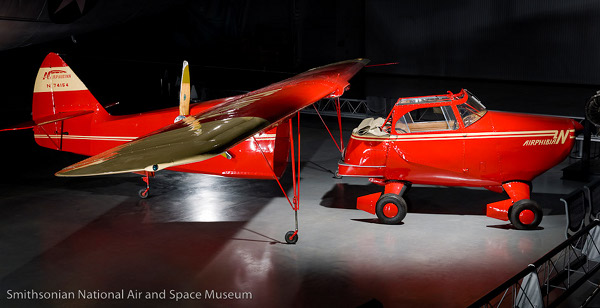
The Airphibian was designed to tow itself to the airport where the fuselage, wings and propeller would be fitted for flight.
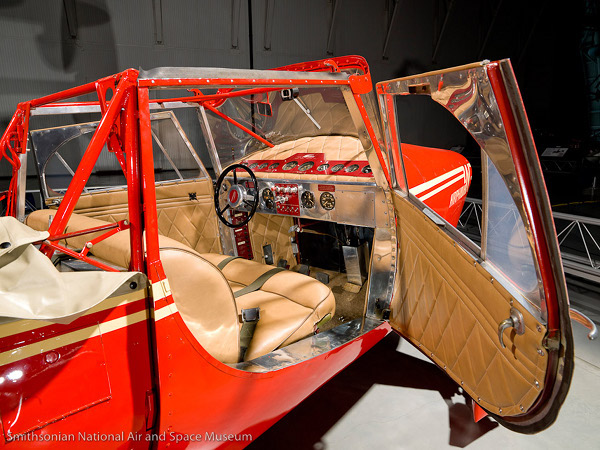
Although it was not a commercial success, the Airphibian had an ingenious design and was beautifully made.

In 1950, the stunning red Fulton Airphibian received the first approved-type certificate for a flying car.



Amphibians, though equally interesting, are perhaps a more practical than flying cars. These aircraft combine the advantages of a flying boat with the convenience of retractable wheels for conventional landings and takeoffs. Typical of this particular aircraft was the Republic RC-3 Seabee that for several decades found a small niche in the general-aviation market. Designed for safety with its 215-horsepower Franklin 6A8 engine and Hartzell controllable-pitch propeller installed behind the enclosed four-seat cabin, the all-metal Seabee was first flown in 1945. It was produced for only two years but was so popular that more than 1,000 examples were sold before the postwar recession curtailed production. Though underpowered, the Seabee gained a loyal following as its unusual design permitted considerable flexibility in operation.
This Bücker Bü 133 Jungmeister aerobatics biplane was flown by champion pilot Beverly “Bevo” Howard.
Ever since the beginning of aviation, air shows have thrilled crowds around the world. Soon after the Wright brothers took to the air, they and countless imitators sought to demonstrate the superiority of their products through aerial demonstrations. First by racing and later by daring aerial maneuvers, they captivated the attention of aviation enthusiasts. In addition to converted military fighters, such as Al Williams’s Gulfhawk s, specially-built aircraft were eventually produced to sustain the high stresses of aerobatics. By the 1930s, and especially after the Second World War, several purpose-built civil designs gained wide popularity.
First flown in 1935, the German-built Bücker Bü 133 Jungmeister is typical of this type of aircraft. A rugged biplane powered originally by a single 160-horsepower Siemens Sh.14 radial, the Bü 133A was designed as a two-seat advanced trainer. Highly maneuverable with a high power-to-weight ratio and fitted with ailerons on both sets of wings, the Jungmeister (Young Master) quickly gained a loyal following among aerobatic contestants.
NASM’s Jungmeister is the most famous of all. In 1936, Romanian aerobatic champion Alex Papana brought this aircraft to the United States on board the German airship Hindenburg. One year later, after competing in the National Air Races in Cleveland, and flying throughout the United States for several years, Papana sold the aircraft to American Mike Murphy in 1939. The aircraft had been severely damaged when a P-12 landed on top of it at Midway Airport, Chicago. Murphy repaired the Jungmeister and flew it to victory in the U.S. Aerobatic championships before selling it in 1941 to another former U.S. Aerobatic Champion, Beverly “Bevo” Howard.
After fitting a new, more-powerful 185-horsepower Warner Scarab engine, Howard flew his Bü 133 for many years in air shows and competitions, particularly at the graduation ceremonies of the Hawthorne Flying Service of Charleston, South Carolina, of which he was president. Regrettably, Howard lost his life in this aircraft during a public performance in Greenville, North Carolina, in October 1971. His estate honored his wishes and donated the restored aircraft to NASM in 1973.
Art Scholl, another famous aerobatic pilot, is also well represented in the collection. His specially modified de Havilland DHC-1A Super Chipmunk, which he flew in international exhibitions for several years, was given to the Museum in 1987. In mid-1945, de Havilland Aircraft of Canada had decided to begin development of a tandem two-seat trainer as a follow-on to the British parent-company’s long line of distinguished trainers. First flown on May 22, 1946, the DHC-1 Chipmunk was the first original design produced by the de Havilland Aircraft of Canada and it found a ready market throughout the British Commonwealth. The all-metal monoplane featured a single-spar wing that was stressed to nine gs. Interestingly, although a Canadian design, the Chipmunk was built in greater numbers in Great Britain by the parent company. Of the total 1,219 built, only 219 were produced in Canada. The British version was stressed to 10 gs and featured a framed canopy and minor variations that included a more-forward-mounted landing gear.
Famed aerobatic pilot Art Scholl flew this modified de Havilland DHC-1A Super Chipmunk in breathtaking aerial performances at numerous airshows in the 1960s, 70s, and 80s.

Art Scholl acquired his Canadian-built Chipmunk in 1968 and promptly made several substantial modifications. While keeping the aircraft’s bubble canopy, Scholl converted the aircraft to a single-seater, clipped the wings by 18 inches, installed a new fin and rudder, and fitted a retractable landing gear. In addition, he removed the flaps and extended the ailerons. Scholl greatly increased its performance by exchanging the standard 140-horsepower Gypsy Major engine with a 280-horsepower Lycoming GO-480-G1D6 that drove a variable-pitch propeller. This Super Chipmunk was now capable of astounding aerobatics in the talented hands of Art Scholl, who flew it in countless breathtaking aerial demonstrations for many years. Only his untimely death while filming scenes in the movie “Top Gun” cut short his promising career.
During the Second World War, Homestead, Florida, resident Curtis Pitts envisioned a tiny biplane powered by a single Lycoming engine ranging in power from 120-150 horsepower and possessing much greater aerial maneuverability than larger contemporary types. His first version crashed in 1945 after flying for only two weeks. Undaunted, Pitts persisted and in 1946 finished his second aircraft and the first production version of the soon-to-be-famous Pitts Special S-1C. Flown in air shows for several years by Phil Quigley, who was in Pitts’s employ as test pilot, the Special was sold to Betty Skelton in 1948 for $3,000. She named the diminutive aircraft Little Stinker Too in deference to her Great Lakes 2T1A in which she won her first Feminine International Aerobatic Championship in January 1948.
In this aircraft, Skelton won her second championship in 1949 after modifying the aircraft with a different propeller and installing a second turn-and-bank indicator for inverted flight. Repainting the aircraft in its distinctive red and white stripes, Skelton renamed the aircraft Little Stinker and flew it to victory in the 1950 Feminine International Aerobatic Championship. Betty Skelton later sold the aircraft but eventually reacquired her old friend. In 1985, she and her husband Donald Frankman donated it to the Museum.
But this is not the only Pitts Special in the collection. Based partly on the success of Little Stinker and numerous impressive aerobatic displays later by other pilots in their own Specials, Pitts’s design slowly gained a loyal following in the aerobatic community. The aircraft became a big success in the early 1960s after Curtis Pitts made the aircraft plans available to the homebuilder market. The Pitts Special soon became the aircraft of choice in U.S. aerobatic competitions with more than 250 built. A Pitts Special won the U.S. National Aerobatic Championship in 1966 and for many years thereafter until it was supplanted by monoplane designs.
In 1973, the Smithsonian borrowed and later acquired the S-1S Special Maryann from U.S. National Aerobatic team member J. Dawson Ransome to commemorate the team’s victory in the 1972 World Championships. This slightly larger version of the popular S-1C featured four ailerons rather than the original two symmetrical airfoils, and a 180-horsepower Lycoming power plant.
With the Laser 200, Leo Loudenslager won an unprecedented seven U.S. National Aerobatic Championship titles between 1975 and 1982, as well as the 1980 World Champion title. The airplane originated as a Stephens Akro, but by 1975 Loudenslager had completely modified the airplane with a new forward fuselage, wings, tail, and cockpit. The Laser 200 emerged as a lighter, stronger, and more powerful aircraft, enabling Loudenslager to perform sharper and more difficult maneuvers.
In 1971, Loudenlagser competed in his first contest at the second level of competition and then immediately proceeded to the highest level, unlimited. He flew at the U.S. nationals and amazingly came in eighth in the men’s division. He won his first U.S. National Championship title in 1975 and repeated in 1976, 1977, and 1978, and then again in 1980, 1981, and 1982. Aerobatic champion and judge Clint McHenry once said he had only seen two perfect aerobatic routines and both were flown by Loudenslager. Retiring from competition flight in 1983, Loudenslager continued to fly at air shows around the country until his death (not flight-related) in 1997. In 1983, the Laser was painted in the brilliant red Bud Light scheme to reflect its sponsorship.
Loudenslager’s legacy is evident in the tumbling and twisting but precise routines flown by current champions and air show pilots. The Laser 200 heavily influenced the look and performance of the next generation of aerobatic aircraft, including the Extra, which dominated competition throughout the 1990s. The Laser 200 was donated by the Loudenslager family in 1999.
The Museum’s Sukhoi Su-26M was flown by the Soviet National Aerobatics Team in 1990 and 1991. The Su-26 is known for its outstanding strength and maneuverability.
For decades international aerobatic competitions were dominated by competitors from Eastern Europe and the former Soviet Union. In 1983, the Sukhoi Design Bureau, makers of Soviet and Russian military aircraft, designed the Su-26 for unlimited aerobatic competition. First flown in June 1984, the Su-26M was first used by the Soviet Aerobatic Team in August 1984 to participate in the World Aerobatic Championships in Hungary. The Su-26 showed its mettle during the next world competition, which was held in the United Kingdom in 1986, when the Soviet team won the coveted team prize for the men’s competition. The Su-26M airplane routinely challenged the German Extra and French Cap series aerobatic and air show airplanes in national as well as world competitions. Soviet and later Russian pilots flew the design to multiple aerobatic titles. Since the early 1990s, the design has been a very successful export for Russia and is now used by many European and American aerobatic competitors and air show pilots.
The Su-26M is made of more than 50 percent composite materials and has a special symmetrical wing section and arched, cantilever, titanium landing gear. It was designed to handle loads from +12 gs to -10 gs and is a superior aircraft for the most highly skilled pilot. It can perform spectacular gyroscopic maneuvers and quick, multiple snap-rolls, and can nearly hover from its propeller.
The Museum’s Su-26M, built in 1990, was flown by the Soviet National Aerobatic team in 1990 and 1991. U.S. aerobatic pilot Gerry Molidor bought it in 1998 and flew it in advanced and unlimited competition until September 2001, when he was forced to retire from unlimited aerobatic competition due to a serious eye injury. The airplane was subsequently acquired by Anheuser-Busch, which donated it to the Museum in 2003.
While not involved in competitive aerobatics, the art of skywriting combines aerobatics with advertising. The TravelAir D4D is one of more than 1,200 Travel Air open-cockpit biplanes built between 1925 and 1930. Popular and rugged, Travel Airs earned their keep as utility workhorses and record breakers. The design was the first success for three giants of the general aviation industry, Lloyd Stearman, Walter Beech, and Clyde Cessna, who in 1925 established the Travel Air Manufacturing Company in Wichita, Kansas.
From 1931 to 1953, Andy Stinis performed skywriting in this airplane for Pepsi-Cola. During those years, skywriting with smoke was a premier form of advertising, and Pepsi-Cola used it more than any other company. Pepsi-Cola acquired the airplane in 1973 and used it for air show and advertising duty until retiring it in 2000. Peggy Davies and Suzanne Oliver, the world’s only active female skywriters since 1977, performed in it until the aircraft was grounded. The Pepsi-Cola Company donated the aircraft in 2000.
In 2000, NASM acquired a truly legendary aerobatic aircraft from a truly legendary pilot. Flown by R.A. “Bob” Hoover for nearly 20 years, N500RA is the most recognized Shrike Commander in the world. Hoover used his extensive test pilot and fighter pilot skills to become a legendary air show pilot and brought a simple business aircraft to international attention.
The Shrike Commander is a descendent of the 1948 L-3805 Aero Commander, a light, twin-engined, six/seven-seat, high-wing aircraft built by the Aero Design and Engineering Corporation of Culver City, California. In 1960, the company changed its name to Rockwell Standard and then merged with North American in 1967. The aircraft became the Shrike Commander, a twin-engine business aircraft powered by two fuel-injected, 290-horsepower, piston-turbo Lycoming engines. In 1973, the Rockwell International name appeared as a result of more mergers. Between 1968 and 1979, when production ended, Rockwell produced 316 Shrike Commanders.
In the 1950s, Bob Hoover, a World War II combat fighter pilot and accomplished test pilot who flew the chase plane on Chuck Yeager’s historic first supersonic flight in 1947, began flying North American aircraft, most famously the P-51 Mustang, at military bases and then at major civilian air shows. In 1973, he began flying the Shrike Commander model in civilian air shows across the country. Hoover bought the aircraft in 1979 and painted it in a distinctive white and green paint scheme with his name on the top of each wing. Hoover’s flight routine demonstrated the Shrike’s excellent high- and low-speed handling capabilities and its one-engine and no-engine performance. But because it was a stock business aircraft that lacked highly modified engines and quick climb or turn characteristics, the Shrike Commander was a more challenging aircraft for air show flight than his P-51 fighter. In addition to 16-point rolls and loops, Hoover flew a precise deadstick (no-engine) maneuver with a loop, eight-point roll, a 180-degree turn to a touchdown with first one wheel and then the other wheel, landing, and taxi to air show center.
One particular maneuver demonstrated Hoover’s superb pilot skills in both the Shrike and the Sabreliner, but it is only visible on film. At altitude, Hoover set a glass on top of the instrument panel and proceeded to pour iced tea into the glass from a pitcher in his right hand while using his left hand to completely roll the aircraft. Combining centrifugal force with smooth handling of the controls, he never spilled a drop of tea. In 2000, Hoover decided to retire the aircraft and gave it to the Museum, flying it to Dulles himself and literally taxiing it into the building upon arrival.
Bob Hoover performed aerial acrobatics for 20 years in his Shrike Commander, a twin-engined business aircraft.
NASM has many other interesting and unique aircraft ranging from high-performance racing machines to ultralights and homebuilts, and even to flying automobiles. These, too, form an important part of the National Aeronautical Collection.
Forced to suspend competition until after the war, the National Air Races resumed competition in 1946. Because surplus high-performance military aircraft were available and because of the demise of the private aircraft builder, the next generation of air race competitors flew modified fighters, particularly P-51s and P-39s. One of these individuals was famed pilot Paul Mantz, who had established a career as a racer and as a stunt pilot for the movies.
Mantz acquired a surplus North American P-51C Mustang in the hope of competing in the reborn Bendix transcontinental air race. Mantz greatly improved the Mustang’s already excellent range by sealing the interior of the wings and using this space as a fuel tank. This “wet wing” enabled Mantz to fly non-stop from Los Angeles to Cleveland, the home of the National Air Races, and win the 1946 and 1947 Bendix Trophy. Naming his Mustang Blaze of Noon, Mantz piloted his aircraft to a coast-to-coast speed record in both directions. This same aircraft, with other pilots at the controls, placed second in 1948 and third in 1949, a remarkable achievement.
Charlie Blair flew Excalibur III, a modified North American P-51C Mustang, on a record-setting flight across the North Pole in 1951.
After the 1949 Bendix, Mantz sold his P-51C to Pan American pilot Charles F. Blair, who hoped to set a solo, around-the world speed record. Blair, who had set several flying boat records while flying for American Export Airlines during the war, renamed the aircraft Excalibur III in honor of the Vought Sikorsky VS-44 Excalibur flying boats he had flown earlier.
On August 16, 1969, Darryl Greenamyer shattered the 30-year-old speed record set by a Messerschmitt Me 209 in his modified Grumman F8F-2 Bearcat Conquest 1.
Forced to abandon his plans because of the Korean War, Blair instead set a new speed mark on January 31, 1951, flying between New York and London nonstop in only 7 hours and 48 minutes. He returned to the United States by an unorthodox route—via the North Pole. He had pioneered aerial navigation at extreme latitudes by devising a system that relied on the careful plotting of sun lines at specific times and locations, obviating the need for a magnetic compass, which is highly unreliable in the polar regions.
Though his theory was untested, Blair took off on May 29, 1951, from Bardufoss, Norway, heading for Fairbanks, Alaska. With no other navigation aids, he flew over the North Pole and landed safely in Fairbanks after a flight of 10 hours and 27 minutes over the barren Arctic Ocean. For this Blair was later awarded the prestigious Harmon Trophy. Undaunted, he continued his flight flying onward to New York in another record-setting time of 9 hours and 30 minutes. Two years later, Blair sold Excalibur III to Pan American Airways, which then donated it to the National Air & Space Museum. It was restored in 1977.
P-51 Mustangs were not the only World War II-vintage aircraft to find a second career after military service. Designed during the war and working up to squadron service just as the conflict ended, the Grumman F8F-2 Bearcat was a most impressive naval fighter. Designed to operate from any of the Navy’s carriers, the diminutive Bearcat combined the smallest possible airframe with the largest available engine—the 2,100-horsepower Pratt & Whitney R-2800. This produced a fighter of exceptional speed, maneuverability, and climbing performance. Smaller than the Vought F4U Corsair and therefore less adaptable to other tasks such as close support, the F8F found a ready market after the war with several foreign air forces, particularly the French navy, the Royal Thai air force, and the South Vietnamese air force. In the civilian market, the Bearcat, with its high power-to-weight ratio, became popular in the postwar air-race circuits, particularly in the 1960s when air racing experienced a rebirth of public interest centered on the annual competition at the Reno Air Races.
The Sharp DR 90 Nemesis was the most successful aircraft in racing history, winning 45 of its 48 competitions from 1991 to 1999.
In 1964, former Lockheed test pilot Darryl Greenamyer acquired an F8F-2 he named Conquest 1 for the new 1964 Reno competition. While he failed to win the 1964 event, Greenamyer flew to victory in 1965 and won every year after through 1971. Perhaps his greatest achievement came on August 16, 1969, when he shattered the 30-year-old speed record for piston-engined aircraft that was formerly held by Fritz Wendel in a special-built Messerschmitt Me 209. Greenamyer had already modified his Bearcat by shortening its wingspan by seven feet, installing a tiny bubble canopy, and fitting a larger four-bladed propeller from a Douglas A-1 Skyraider. The engine was tuned to produce 3,200 horsepower. These changes, coupled with careful attention to reducing drag by filling gaps with putty, enabled Greenamyer to set a new speed record of 483.041 miles per hour. He donated his Bearcat to the Museum in 1977.
Another equally successful but rather less imposing racing aircraft is the Mahoney Sorceress. Fitted with only a single 135-horsepower, Lycoming O-290-D2 engine, this unique metal stagger-wing biplane flew to many victories during its distinguished career in the 1970s. Designed and built by Lee Mahoney and his father S.C. Mickey Mahoney, the Sorceress was purchased in 1972 by noted air racing pilot Don Beck who flew it to many more wins. It was the first sport biplane to exceed 200 miles per hour in a closed course and actually reached 245 miles per hour in level flight. So successful was this aircraft that the rules governing its competition qualification were modified to such an extent it was forced into retirement. Don Beck gave his Sorceress to NASM in 1984.
The latest addition to NASM’s stable of champion air racers arrived in the summer of 2000. The Sharp Nemesis, designed and built by a dedicated team led by Jon and Patricia Sharp, completely dominated its corner of the air racing world for a decade. In fact, it is the most successful aircraft in air racing history. Following its first flight in 1991, it won 45 of the 48 contests it entered. This remarkable aircraft won nine consecutive Reno Gold National Championships and set 16 world speed records for its class, including the 3-kilometer mark of 290.08 miles per hour and the 15-kilometer mark of 282.58 miles per hour set in 1998. It was the International Formula One points champion for 1994, 1995, 1996, 1997, and 1998. In 1991, the Nemesis won the George Owl Trophy for design excellence. In 1993, 1996, and 1998 it won the Louis Blériot Medal of the Fédération Aéronautique Internationale for the greatest achievement in speed. In 1993, 1994, 1995, and 1999, the Nemesis won the Pulitzer Trophy for air-racing speed records. The Sharps presented their beloved Nemesis to the Museum during the Experimental Aircraft Association’s annual AirVenture fly-in at Oshkosh, Wisconsin, in July 2000, where it flew for the last time before the Sharps symbolically gave the “keys” (in fact, pink gloves to prop the engine) to NASM director General J.R. “Jack” Dailey.
The dream of flight for everyone has always been hindered by the high cost of purchasing aircraft for personal use. One solution, first pioneered during the Golden Age, was the homebuilt aircraft. These were designed by professional engineers who would sell the plans and usually the parts to enthusiasts who would build these kit aircraft themselves. This industry has grown widely since the 1970s, when the cost of fuel, insurance, and the skyrocketing prices for conventional aircraft almost destroyed the traditional general-aviation industry.
The radical canard-design, all-composite Rutan VariEze set the standard for innovation in homebuilt aircraft in the 1970s.
By far the most prominent proponent of homebuilt aircraft has been Burt Rutan, a leading designer in this burgeoning industry who has pioneered highly innovative designs and the use of exotic, unconventional materials. Built of composite materials and featuring a unique canard design, the Rutan VariEze has been a leading homebuilt design since its inception in 1975. As with many other homebuilts, the VariEze was designed to use an inexpensive, modified, air-cooled, four-cylinder Volkswagen automobile engine, although a Continental aircraft engine could also be fitted. Rutan’s aircraft was distinguished for its sleek design and exceptional performance at a gross weight of less than 1,100 pounds. His revolutionary designs, as well as his dedication to the burgeoning homebuilt industry, have made him a legend in his field. In December 1985, Rutan donated his prototype VariEze N4EZ to the Museum.
Burt Rutan also was instrumental in the creation of a diminutive homebuilt on behalf of Tom Jewett and Gene Sheehan of Mojave, California. Powered by a simple 18-horsepower Onan engine, the single-place Rutan Quickie soon gained a loyal following with hundreds of kits sold since the mid-1970s. Designed for ease of transport and storage, the Quickie weighs only 309 pounds yet has a useful load of 300 pounds. This astonishing achievement is even more impressive in that the aircraft is also capable of flying for more than 65 miles on a single gallon of gasoline, yet can attain speeds of well over 100 miles per hour.
One of the best-known and most controversial homebuilt aircraft is also in the National Collection. In the early 1960s, avid aircraft designer Jim Bede produced his inexpensive kit aircraft, the BD-1. A succession of subsequent designs gained Bede a reputation for interesting and innovative design. Late in 1970, Jim Bede began work on his most distinctive aircraft, the BD-5.
This new design featured a low-wing monoplane, retractable landing gear, and an enclosed single-seat cockpit. The original rear-mounted, two-cylinder, two-cycle, 40-horsepower Kiekhaefer engine drove a pusher propeller through a unique belt drive. The aircraft was sold in kit form for $2,100 and as a completed, fully certificated aircraft for $4,400. Builders had the choice of installing a 21.5-foot-wide wing or a shorter 14.3-foot wing for more experienced pilots. The aircraft was fully aerobatic and extremely fast for its 600-pound fully-loaded weight, with a reported top speed of more than 200 miles per hour.
The sleek lines of this beautiful aircraft belied a history of problems. The clean, closely-cowled engine installation created cooling problems; the original engine had insufficient power. Bede and many other owners tried numerous solutions, eventually finding a turbocharged, converted Honda Civic automobile engine to be the best solution. Later Bede also offered a jet–powered version of his tiny aircraft, the BD-5J, which used a small axial-flow turbojet.
However, other problems plagued the BD-5. Construction was not as easy as promised. Instead of taking fewer than 300 hours to assemble, builders found that construction of the BD-5 usually required about 5,000 hours of work. More worrisome was the company’s inability to deliver hundreds of kits to customers on time. Nevertheless, despite the tumultuous history of the BD-5 series, over 3,000 kits were sold. Peter K. Graichen built the Museum’s example, which he and co-owner Albert C. Beckwith donated on September 11, 1984, after flying it only nine hours.
Civilian aircraft take many forms. Sailplanes and hang gliders are perhaps the purest form of flying, soaring high above the earth unencumbered by an engine and dependent solely upon the wind and other forces of nature for flight.
Before the Second World War, Germany was the undisputed leader in sailplane and glider design, examples of which are in the National Collection. To evade flight training restrictions imposed by the victorious Allies after the First World War, Germany turned to sailplanes to train its next generation of pilots. The Grunau 2b, designed in 1935 by Edmund Schneider of Silesia, was typical of these aeronautical efforts. Based on the earlier Grunau 1, the 2b was a basic glider trainer, not a high-performance design. No less than 10,000 were built and, launched from hilltops throughout Germany, the Grunaus along with the Schugleiter SG-38s and others taught German pilots how to fly and provided an excellent education in the dynamics of flight.
At the same time in the United States, gliders and sailplanes were also gaining a devoted following. In Michigan, Robert and Wallace Franklin built a wood-and-steel sailplane known as Big Ship, which was demonstrated at the 1929 National Air Races in Cleveland, Ohio. Impressed by the craft’s performance, noted exhibition pilot Frank Hawks purchased the Big Ship and renamed it Eaglet for a proposed flight across the country. With sponsorship from Texaco, Hawks flew the Eaglet from San Diego, California, to New York City from March 3 to April 6, 1930, with many stops in between. His purpose was to inspire people to take up aviation with less expensive gliders rather than with powered aircraft. During his 2,800-mile trek, Hawks was towed by a Waco until he was within range of each destination and then he would release his tow-line and glide to a safe landing. Texaco presented the Eaglet to Paul Garber in 1930. In the meantime, other glider pioneers were taking to the skies.
Trained to fly during the First World War, Hawley Harvey Bowlus gained notice as the plant superintendent of Ryan Airlines, where he helped build Lindbergh’s Spirit of St. Louis in 1927. During this time he built and flew his Albatross I, setting several records in the process. In 1929, Bowlus taught Charles and Anne Lindbergh how to fly sailplanes and in 1931, with German designer Martin Schempp, produced his mahogany plywood Albatross II, a graceful high-performance sailplane that established many soaring records.
In 1937, Bowlus produced a lightweight successor to his successful Albatross II, the new BA-100 Baby Albatross. Incorporating the wing design of the Grunau Baby and an aluminum-tube construction, Baby Albatross design kits were made available for less than $400. Despite some design difficulties and the absence of spoilers to slow its landing speed, the BA-100 proved to be an excellent and popular design.
On the eve of World War II, the Frankfort Sailplane Company acquired the rights to market the Cinema series of craft designed by Stan Corcoran. Developed quickly into the TG-1 to fulfill a pressing need by the U.S. Army for training gliders, the Frankfort glider deliveries were late. They also had defects that had to be corrected, which prevented widespread introduction of the type into military service. Nevertheless, the TG-1a was typical of several similar gliders that were designed to train the members of America’s nascent glider corps during the war.
One of the greatest names in sailplane design is the Schweizer Aircraft Corporation of Elmira, New York. Just before the outbreak of the Second World War, the Schweizer brothers built eight separate all-metal glider designs. During the war, Schweizer built the TG-2 glider trainer for the Army Air Forces and the similar LNS for the Navy. The company also profited from a great deal of subcontracting work for several aircraft manufacturers. After the war, the Schweizers turned their attention back to sailplanes and, in 1945, produced their model 2-22 two-seat trainer. Built of steel tubes and covered with fabric, the 2-22 was available either assembled by the factory or in kit form. With a glide ratio of 17:1, the 2-22 was noted for its docile handling. Its maximum speed was 89 miles per hour and it cruised at 35 miles per hour. A total of 258 Schweizer 2-22s were produced from 1945 until 1967.
Flying this Schweizer 2-22K, Scotty McCray was the first person licensed to perform low-altitude aerobatics in a sailplane.
The all-aluminum, V-tailed Arlington Sisu 1A won the U.S. National Soaring Championship three times in the 1960s.
The Museum’s aircraft is a 2-22K that was assembled from a kit by Byron G. “Scotty” McCray, who was the first sailplane pilot ever licensed to perform low-altitude aerobatics. For 10 years, flying this unmodified 2-22K, McCray performed aerial maneuvers that were thought impossible for a sailplane. His untimely passing in a conventional aircraft accident cut short his distinguished career. On September 22, 1973, McCray’s widow, Helen, donated his Schweizer to the Museum.
The sailplane industry grew rapidly in the postwar years as soaring gained a large following. In Europe and the United States, new builders produced better, more efficient, and stunningly graceful designs to meet this expanding niche market. New materials, particularly composites, have led to new generations of sleek, high-performance sailplanes that seem to defy gravity with their vastly improved glide ratios and lighter airframes.
In 2005, adventurer and aviator Steve Fossett completed the first solo, non-stop, non-refueled flight around the world in his Virgin Atlantic Global Flyer.
In 1958, Convair engineer Leonard Niemi first flew his all-aluminum Arlington Sisu 1A sailplane that he had designed and built. With an excellent 37:1 glide ratio, the sleek, V-tailed craft featured a retractable landing gear and a foam-filled, cantilevered, laminar-flow wing, slotted flaps, and vented air brakes. This Sisu 1A won the U.S. National Soaring Championship three times: in 1962, 1965, and 1967. In 1964, Alvin Parker set three international records in his Sisu 1A, the second one built. After becoming the first sailplane to fly more than 1,000 kilometers, it was donated to the Museum by Parker in 1969. The Arlington Aircraft Division of the Astro Corporation of Greenville, South Carolina, built the Sisu 1A under license. Ten of these sailplanes were produced.
First flown on November 18, 1976, George Applebay’s Zuni II was one of the first American sailplanes designed to feature an all-composite construction. Working with the DuPont Company, Applebay developed his T-tailed, fiberglass, Zuni II 15-Meter Class racing sailplane with the aim to surpass contemporary European designs. Featuring a 38:1 glide ratio and a side-mounted control stick, the Zuni II was the most advanced sailplane of its time. Our example was given to the Museum in 1983 by Mr. J. G. Mercer, the same year that production ended. A total of 20 Zuni IIs were built.
While not technically a sailplane, the Virgin Atlantic Global Flyer combined the high-aspect-ratio wings, composite construction of the latest sailplane designs, highly original design concepts pioneered by Burt Rutan, and a single jet engine to shatter existing around-the-world speed and distance records for non-refueled aircraft. In 2005 and 2006, accomplished aviator, balloonist, and sailor Steve Fossett made three absolute record-setting flights in the turbofan-powered Virgin Atlantic Global Flyer. He became the first to fly solo, nonstop, around the world, flying from and returning to Salina, Kansas, in just over 67 hours (February 28–March 2, 2005). On that trip he also set an around-the-world speed record (551 kilometers per hour/342 miles per hour). Then he set an absolute distance record, flying from NASA’s Kennedy Space Center around the world and landing in Bournemouth, England, in just under 77 hours (February 8–11, 2006; 25,766 miles). Finally, he set a closed-course distance record over Salina, Kansas, of 74.5 hours (March 14–17, 2006; 25,506 miles).
The all-composite Global Flyer was designed and built by Scaled Composites under the direction of Burt Rutan. It contains 13 tanks that hold 2,915 gallons of fuel. Eighty-three percent of the maximum weight is fuel. Fossett delivered the aircraft to NASM in person, flying it into Washington Dulles Airport to a delighted crowd in the summer of 2006.
Though not pure sailplanes, motorized gliders combine the performance of a sailplane with the convenience and safety of an engine. In 1946, Ted Nelson hired noted designer Hawley Harvey Bowlus to create a motor-glider. Based heavily on Bowlus’s Albatross sailplane, the Nelson BB-1 Dragonfly featured a glide ratio of 20:1 and a single 25-horsepower, two-stroke, four-cylinder Nelson H-29 engine. The first motor-glider ever to receive a certificate of airworthiness, the Dragonfly was unfortunately underpowered and, at $3,000 a copy, too expensive for the market.
Two years later, Nelson produced his improved PG-185-B Hummingbird, which incorporated a 40-horsepower engine. The prototype, which is in NASM, was built of wood but the six production versions were of all metal construction. Mr. Charles Rhoades gave both the Dragonfly and the Hummingbird to the Museum in 1973.
“Sport aviation,” “flying for fun,” and a host of other labels ably describe the many facets of the leisure side of general aviation. Sailplanes and motorized gliders comprise the more expensive branch of activity while hang gliders and ultralights, which are effectively powered hang gliders, bring affordable flight to a much wider audience than previously possible. NASM possesses an Eipper-Formance 10 and a Valkyrie hang glider, both from 1975, and a Mitchell U-2 Superwing ultralight that started its life as a hang glider. The unique Ultraflight Lazaire SS EZ is an advanced twin-engined ultralight with an enclosed fuselage and an inverted “V” tail. The Museum’s example flew with and was donated by the police department of Monterey Park, California, where it performed aerial surveillance at a much lower cost than conventional police helicopters.
The unique Pathfinder Plus is an unmanned, solar-powered aircraft that has set several altitude records.

In the late 1970s, others sought to build the ultimate flying machine, a human-powered aircraft. Dr. Paul MacCready and his close-knit team of engineers, friends, and family members turned this dream into a reality on August 23, 1977, when Bryan Allen piloted and pedaled the MacCready Gossamer Condor around a one-half-mile-long figure-eight course, flying above a 10-foot-high obstacle at each end. This triumph won the £50,000 Kremer Prize for the first successful human-powered aircraft and inspired Dr. MacCready to even loftier goals.
After donating the Condor to the Museum in 1978, where it remains on display downtown, Dr. MacCready sought the same challenge that confronted Louis Blériot 70 years before—to fly across the English Channel. Competing for a new Kremer Prize of more than £100,000, MacCready and company fashioned what was essentially a stronger Condor that could be easily transported. Built of carbon fiber-reinforced plastic tubing instead of aluminum, and covered by Mylar plastic, the new Gossamer Albatross was a high-wing monoplane with a canard elevator that weighed less and was stronger than the original Gossamer Condor. Propulsion was provided by the pilot, who turned a two-bladed propeller by pedaling from a reclined position inside the fuselage. On June 12, 1979, the Gossamer Albatross, again with Bryan Allen as pilot, became the first human-powered aircraft to fly across the English Channel. The flight lasted 2 hours and 49 minutes and covered 22.5 miles between Folkestone, England, and Cap Gris Nez, France. Despite calm winds, the flight took much longer than expected and brought Bryan Allen to the verge of exhaustion.
This record stood for years until a team from the Massachusetts Institute of Technology under the leadership of John Langford created the Daedalus, a sophisticated human-powered aircraft designed to replicate the mythical journey of Daedalus from Crete to the Greek mainland. Built of carbon epoxy and covered in Mylar, and with 14-time Greek national bicycle champion Kanelos Kanellopolous at the controls, Daedalus flew from Crete to the island of Santorini, a distance of 72 miles, in just under four hours. An unexpected gust of wind caused the craft to break up and gently crash into the Aegean Sea but not before the record had been set. NASM owns the only surviving pieces.
Inspired by the success of the Gossamer Albatross, Dr. MacCready and his team from AeroVironment turned their attention to the design and construction of a host of radical high-lift, low-weight aircraft powered by unconventional means. MacCready sought to combine his unique aircraft technology with solar power, and his first success came with the Gossamer Penguin, which made its first flight solely on solar cell power on May 18, 1980. The flight lasted only about 30 seconds, with Marshall MacCready as pilot.
Spurred by this achievement, the design team proceeded to build a long-endurance solar-powered aircraft. After much work, the result was the Solar Challenger, a 217-pound aircraft with a wingspan of 47 feet and a length of 30 feet. Power is provided by 16,128 photovoltaic cells that cover the wing and the horizontal stabilizer and produce a steady 2.7 horsepower from its electric motor. As long as the sun shines, the Solar Challenger has an unlimited endurance. To demonstrate the possibilities of solar power and energy conservation, MacCready sent the aircraft up in a series of proving flights. The most dramatic occurred on July 7, 1981, when pilot Stephen Ptacek flew the aircraft across the English Channel from Cormeillesen-Vexin, France, to the Royal Air Force Base at Manston, England. The 5-hour and 23-minute flight covered a distance of 230 miles during which Ptacek reached a top speed of 47 miles per hour and an altitude of 12,000 feet. This success has led AeroVironment to produce exotic experimental high-altitude, unmanned reconnaissance aircraft that typify MacCready’s innovative ideas and his special knack for problem-solving. The following year, Dr. MacCready presented the aircraft to the Museum, where it was briefly on display before it was lent to the Science Museum of Virginia in Richmond.
Perhaps the most extreme iteration of MacCready’s ultra-lightweight solar-powered design is the Pathfinder Plus unmanned aircraft. Designed and built by AeroVironment, Pathfinder Plus is a high-altitude, solar-powered, unmanned experimental aircraft intended to explore the possibilities of unlimited-duration, high-altitude reconnaissance. During the 1990s, it conducted 10 test flights, three of which set altitude records, the highest of which was 24,445 meters (80,201 feet). The aircraft was built under the sponsorship of the Lawrence Livermore National Laboratory and the Ballistic Missile Defense Organization. It has a carbon-fiber main spar and is covered with a polymer skin and silicon solar cells that power eight electric motors. The project was later managed by NASA’s Dryden Flight Research Center before the machine was given to the Museum by its builder in 2007.
The graceful Lockheed L-1049 Super Constellation set the standard for air travel in the 1950s flying with the airlines and the military.
On a much larger scale than general aviation, civil aviation embraces one of the world’s great industries—commercial air transportation. The major technological developments in this field have had a profound effect not only on the airlines and their rise to prominence but on the way that we now view our world. In the 1920s, airlines linked countries in hours rather than in days spent in surface travel. The development of large four-engined, piston-powered airliners of the 1940s and 1950s first united the continents in hours rather than days spent in the elegant but slow flying-boats of the 1930s. By the late 1950s, jet airliners made it possible to travel virtually anywhere on the planet in a day. Such an achievement, the social, political, and economic effects of which have helped to create global economies, is reflected in some of the major exhibits and artifacts in the National Air and Space Museum.
Air travel in the 1940s and 1950s was the heyday of the large piston-engined airliner. Air fares were still beyond the reach of most people and air travel was confined to luxury travel for the wealthy, the privileged, and the business executive. Air travel was elegant and travelers dressed appropriately. One aircraft that well illustrates that romantic age is the graceful, dolphin-shaped Lockheed Constellation.
The introduction of the Lockheed Constellation into commercial service following the end of the Second World War greatly intensified transcontinental competition. Sleek and powerful, with their distinctive triple fins and rudders (designed so that the aircraft could fit inside existing hangars), the graceful “Connies” dramatically lowered travel times and introduced unheard-of pressurized comfort. When Transcontinental and Western Air (TWA) began flying Constellations in March 1946, passengers could travel from New York to Los Angeles in 11 hours with only one 25-minute fuel stop, five hours shorter than United’s New York–San Francisco schedule with the slower, unpressurized Douglas DC-4s. The one-way fare of $118.30 matched United’s, although TWA added an extra $25 for the Constellation’s “Advanced Sky Chief” service. Connies became so successful that by the 1950s hundreds were in service with airlines around the world providing unprecedented levels of high-quality air service to thousands of travelers each day.
By the early 1950s in the United States, competition between manufacturers and between airlines was intense. The pressurized DC-6 and later the longer-ranged Douglas DC-7 transports forced Lockheed to develop improved versions of the standard Constellation series. In 1951, the Lockheed L-1049 Super Constellation entered service with Eastern Air Lines. This was a “stretched” version of the standard 44-seat Constellation and could carry 71 passengers. The L-1049C and later variants were powered by four new Wright R-3350 Turbo Compound engines that initially produced 3,250 horsepower, giving the aircraft a top speed in excess of 350 miles per hour. Northwest Orient and TWA in particular also operated Super Constellations. These aircraft and their competitors from Douglas ruled the skies until the advent of jet travel.
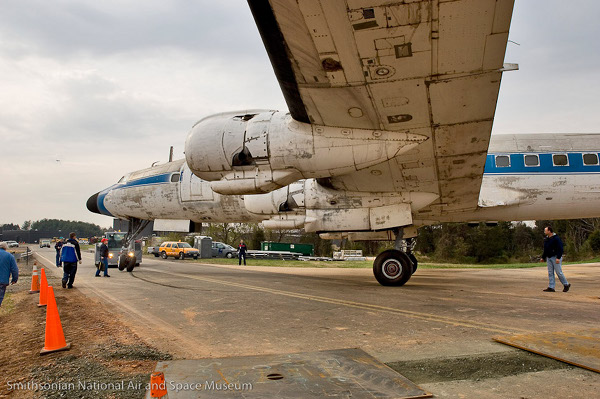
The Super Connie was towed to an empty hangar at Dulles airport to be repainted.
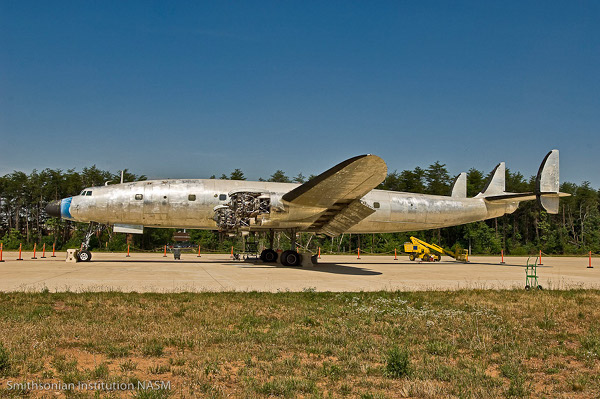
The Super Connie sits stripped, ready for its new paint.
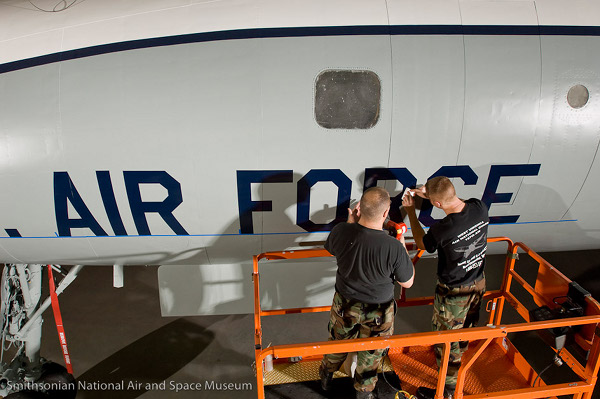
NASM restoration specialists apply the correct U.S. Air Force markings.
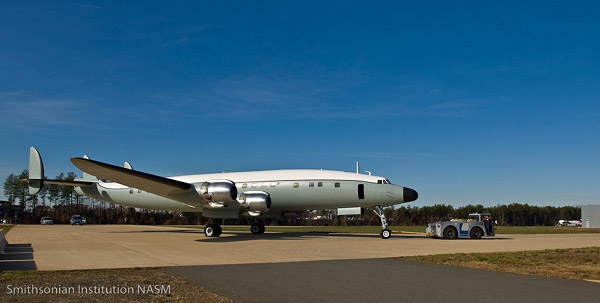
With the cleaning and painting finished, the C-121C is moved to the Udvar-Hazy Center.
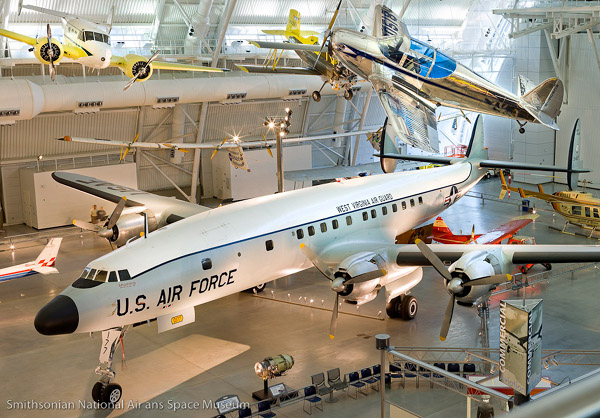
The Super Constellation is now displayed in its correct markings from the West Virginia Air National Guard in the south end of the Boeing Aviation Hangar.
The L-1049F variant of the Super Constellation, featuring a strengthened landing gear, was used by the U.S. Air Force to fly cargo and personnel for many years. After being withdrawn from frontline duty, some of the 33 L-1049Cs flew with all-cargo airlines as well as second- and third-level airlines around the world. The Museum’s Super Constellation is one of these.
Acquired in 1988, our L-1049C started life as an Air Force C-121C flying for the 1608th Air Transport Wing of the Atlantic Division of the Military Air Transport Service based in Charleston, South Carolina. For more than 20 years, this Connie flew cargo and personnel around the globe, later being used by the Mississippi, West Virginia, and Pennsylvania Air National Guards before it was sold to a civilian operator. When plans to create a small airline serving Las Vegas and Los Angeles fell through, the aircraft was acquired by NASM. It was flown across the country to Washington Dulles International Airport where it resides today, restored in its markings of the 167th Military Airlift Squadron, West Virginia Air National Guard.
Immediately after the Second World War, airlines began to search for a more efficient, pressurized replacement for the venerable Douglas DC-3. Engineers at Boeing and Lockheed offered proposals but none saw production. Designers at Martin and Convair, however, did find success. The Martin 2-0-2 and 4-0-4 series were widely flown but their careers were marred by structural problems. Far more successful was the pressurized Convair 240 series.
Searching for a replacement for the DC-3 in 1945, American Airlines initiated a design requirement for a modern, pressurized, twin-engined, 40-seat airliner for use in local service. The product was the Convair 240 (with 2 engines and 40 passengers—hence the name). As launch customer, American placed an initial order for 100 of the new CV-240s (later reduced to 75).
The CV-240 first flew on March 16, 1947, and was delivered to American on February 28, 1948. It was the first pressurized twin-engined airliner to enter service. A more powerful version built for United Air Lines was introduced in 1952 as the Convair 340. This aircraft featured a longer fuselage to carry 44 passengers as well as a larger wing that gave the aircraft improved high-altitude performance. The last piston-engined variant was the CV-440 Metropolitan, which incorporated improved sound-proofing and optional weather-radar. Some 170 340/440s were eventually converted into CV 580s by replacing the Pratt & Whitney R-2800 piston engines with Allison 501-D13 turboprops of 3,750 shaft horsepower. Sales of the 240/340/440 series to the airlines and the military totaled more than 1,000 between 1947 and 1956.
The Museum is fortunate to preserve in its collection a very special Convair 240. This is the Caroline, the first private aircraft ever used by a candidate during a presidential campaign. It was used by Sen. John F. Kennedy during his successful 1960 campaign for the Democratic Party nomination and subsequent campaign for president. Historians credit this aircraft with providing Kennedy with the narrow margin of victory because it allowed him to campaign more effectively during that very hotly contested race. The Caroline, named after President Kennedy’s daughter, revolutionized American politics; since 1960, all presidential candidates have used aircraft as their primary means of transportation.
This historic aircraft was built in August 1948 and delivered to American Airlines, which operated it until 1959 when Joseph Kennedy purchased the aircraft and fitted it with an executive interior for his son’s 1960 presidential campaign. For security reasons, President Kennedy rarely used the aircraft after the election but the family used it until 1967.
In September 1967, on behalf of his family, Sen. Edward Kennedy approached Smithsonian Secretary S. Dillon Ripley with an offer to donate the aircraft. Recognizing the eventual historical significant of the aircraft, Ripley suggested that NASM accept the aircraft. The aircraft was donated on November 17, 1967, during a ceremony at National Airport attended by Ripley and the Kennedy family. Interestingly, from 1975 until 1982, the Smithsonian Museum of American History recognized the significance of the Caroline by borrowing the interior for its popular “We the People” exhibit. Following the close of the exhibit, the interior was lent to the Kennedy Library until it was returned in 1993. It is currently in storage.
A revolution occurred in air travel when, in the 1950s, powerful and durable jets enabled aircraft manufacturers to build bigger, faster, and more-productive airliners. With their high speeds and low operating costs, jet airliners enabled the airlines to provide lower fares, which greatly expanded the passenger demand for air travel.
Although jet airliners such as the British de Havilland D.H. 106 Comet and the Soviet Tupolev Tu-104 entered service earlier, the Boeing 707 and Douglas DC-8 were bigger, faster, had greater range, and were more profitable to fly. First flown in December 1957, the 707 was developed from the 367-80, or “Dash 80,” the prototype for the U.S. Air Force’s KC-135 jet tanker and the progenitor of Boeing’s long line of distinguished jet transports.
In the early 1950s, Boeing had begun to study the possibility of creating a jet-powered military transport and tanker to complement the new generation of Boeing jet bombers entering service with the U.S. Air Force. When the Air Force showed no interest, Boeing invested $16 million of its own capital to build a prototype jet transport in a daring gamble that the airlines and the Air Force would buy it once the aircraft had flown and proven itself. As Boeing had done with the B-17, it risked the company on one roll of the dice and won—handsomely.
Boeing engineers had initially based the jet transport on studies of improved designs of the Boeing 367-80, better known to the public as the C-97 Stratofreighter, a piston-engined transport and aerial tanker based on the B-29 bomber. By the time Boeing progressed to the 80th iteration, the design bore no resemblance to the C-97 but, for security reasons, Boeing decided to let the jet project be known as the 367-80, or the Dash 80.
Work proceeded quickly after the formal start of the project on May 20, 1952. The 367-80 mated a large cabin based on the dimensions of the C-97 with the 35-degree swept-wing design based on the wings of the B-47 and B-52 but considerably stiffer and incorporating a pronounced dihedral. The wings were mounted low on the fuselage and incorporated high-speed and low-speed ailerons as well as a sophisticated flap and spoiler system. Four Pratt & Whitney JT3 turbojet engines, each producing 10,000 pounds of thrust, were mounted on struts beneath the wings.
Upon the Dash 80’s first flight on July 15, 1954 (the 34th anniversary of the founding of the Boeing Company), Boeing clearly had a winner. Significantly larger than the de Havilland Comet and flying 100 miles per hour faster, the new Boeing had a maximum range of more than 3,500 miles. As hoped, the Air Force bought the design as a tanker/transport, assigning it the designation of KC-135A.
Boeing quickly turned its attention to selling the airline industry on this new jet transport. Clearly the industry was impressed with the capabilities of the prototype 707 but never more so than at the August 1955 Gold Cup hydroplane races held on Lake Washington in Seattle. During the festivities surrounding this event, Boeing had gathered many airline representatives to enjoy the competition and witness a flypast of the new Dash 80. To the audience’s intense delight and Boeing’s profound shock, test pilot Alvin “Tex” Johnson barrel-rolled the Dash 80 over the lake in full view of thousands of astonished spectators. While breaking every rule imaginable, Johnson’s vividly display convinced the airline industry of the Dash 80’s superior strength and performance.


In searching for a market, Boeing found a ready customer in Pan American Airway’s president Juan Trippe, who had been spending much of his time searching for a suitable jet airliner to enable his pioneering company to maintain its leadership in international air travel. Working with Boeing, Trippe overcame Boeing’s resistance to widening the Dash-80 design, now known as the 707, to seat six passengers in each seat row rather than five. Trippe did so by placing an order with Boeing for 20 707s but also ordering 25 of Douglas’s competing DC-8, which had yet to fly but could accommodate six-abreast seating. At Pan Am’s insistence, the 707 was made four inches wider than the Dash 80 so that it could carry 160 passengers six-abreast.
In October 1958, Pan American ushered the jet age into the United States when it opened international service with the Boeing 707. National Airlines inaugurated domestic jet service two months later using a 707-120 borrowed from Pan Am. American Airlines flew the first domestic 707 jet service with its own aircraft in January 1959, and set a new speed mark when it opened the first regularly-scheduled transcontinental jet service later that year. Subsequent nonstop flights between New York and San Francisco took only five hours, three hours less than by the piston-engine DC-7. The one-way fare, including a $10 surcharge for jet service, was $115.50, or $231 for a round trip. The flight was almost 40 percent faster and almost 25 percent cheaper than flying by piston-engine airliners. The consequent surge of traffic demand was substantial.
The 707 was originally designed for transcontinental or one-stop transatlantic range. But modified with extra fuel tanks and more efficient turbofan engines, the 707-300 Intercontinental series aircraft could fly nonstop across the Atlantic with full payload under any conditions. Boeing built 855 707s, of which 725 were bought by airlines worldwide.
The Dash 80’s career did not end after the first flight of the 707. This remarkable aircraft served as a test bed for numerous Boeing and NASA projects for the next 15 years until it was retired to NASM in 1972. It tested new engines for the 707, different wings, flaps, airfoil shapes, and a variety of other important features, many of which were incorporated into later aircraft.
In the 1950s, air travel was revolutionized with the advent of jet propulsion. First the de Havilland Comet and, later, the Boeing 707, greatly increased the speed of travel from 350 to over 600 miles per hour. Airlines and customers flocked to the new jet airliners as travel times were cut dramatically and the seat-mile costs to the airlines dropped. The conclusion drawn by engineers, managers, and politicians seemed clear: the faster the better. Unfortunately, they were wrong.
In Europe, enterprising designers in Great Britain and France were independently outlining their plans for a supersonic transport (SST). In November 1962, in a move reminiscent of the Entente Cordiale of 1904, the two nations agreed to pool their resources and share the risks in building this new aircraft. They also hoped to highlight Europe’s growing economic unity as well as its aerospace expertise in a dramatic and risky bid to supplant the United States as the leader in commercial aviation. The aircraft’s name reflected the shared hopes of each nation for success through cooperation—Concorde.
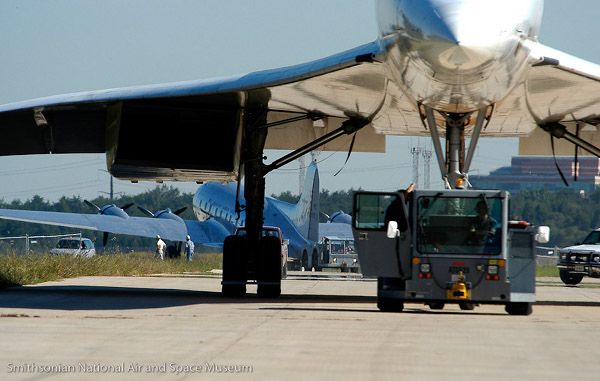
The Boeing 307 waits its turn as the Concorde Supersonic Transport is towed to the Steven F. Udvar-Hazy Center.
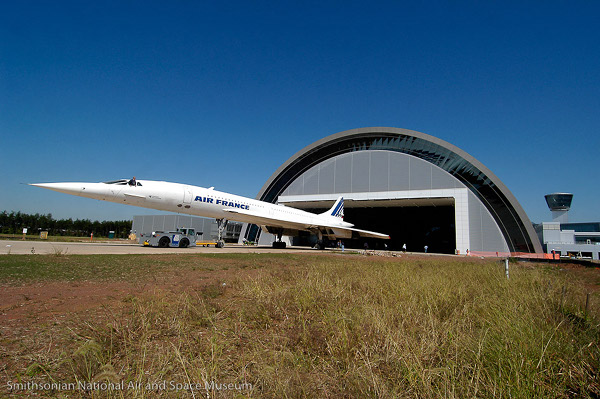
With the help of ground crew and mechanics from United Airlines, the Concorde is safely backed into the Boeing Aviation Hangar.
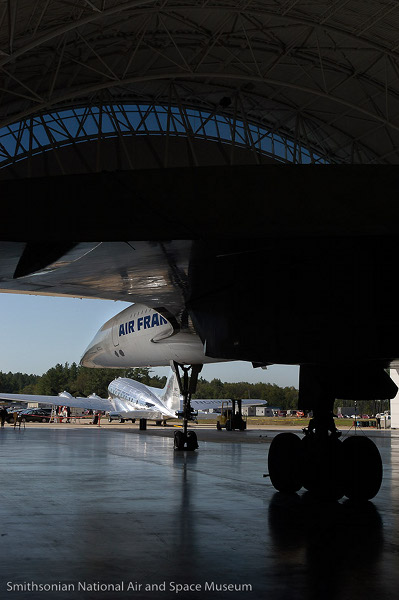
Once the sleek Concorde is in position, it is time for the Boeing 307 to move into the building.
The Concorde was the world’s only supersonic airliner to attain sustained service, flying for 27 years before the fleet was retired in 2003.
The designers at the British Aircraft Corporation and Sud Aviation, later reorganized as Aerospatiale, quickly settled on a slim, graceful form featuring an ogival delta wing that possessed excellent low-speed and high-speed handling characteristics. Power was to be provided by four massive Olympus turbofan engines built by Rolls-Royce and SNECMA. Realizing that this first-generation SST would cater to wealthier passenger, Concorde’s designers created an aircraft that carried only 100 seats in tight, four-across rows. They assumed that first-class passengers would flock to the Concorde to save valuable time while economy-class passengers would remain in the larger, slower subsonic airliners.
While mounting costs constantly threatened the program, as construction continued with exactly 50 percent of each aircraft in each country, the first Concorde was ready for flight in 1969. With famed French test pilot Andre Turcot at the controls, Concorde 001, which was assembled at Toulouse, took to the air on March 2, 1969. Although the Soviets had flown their version of the SST first, the Tupolev Tu-144 had been rushed into production and suffered from technological problems that could never be solved. Following the successful first flight, a total of four prototype and preproduction Concordes were built and thoroughly tested and by 1976 the first production Concordes were ready for service.

Because of the high angle-of-attack required by delta wings, the Concorde featured exceptionally tall landing gear.
But across the Atlantic all was not rosy. During this time, America sought to produce its own bigger and faster SST. After a contentious political debate, the federal government refused to back the project in 1971, citing environmental problems, particularly noise—the sonic boom—and engine emissions that were thought to harm the upper atmosphere. Anti-SST political activity in the United States delayed the granting of landing rights, particularly into New York City, causing further delays.
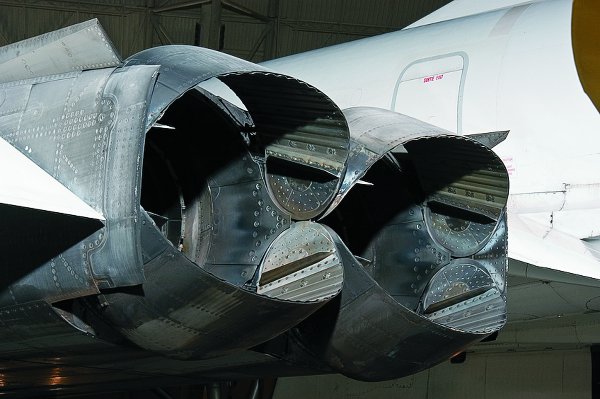

Four massive Bristol/SNECMA Olympus turbofans powered the Concorde.
More ominously for the Concorde, no airlines placed orders for this advanced SST. Despite initial enthusiasm, the airlines dropped their purchase options once they calculated the operating costs of the Concorde. Consequently, only Air France and British Airways—the national airlines of their respective countries—flew the 16 production aircraft, and only after purchasing them from their governments at virtually no cost.
Nevertheless, in January 1976, Concorde service began and by November these graceful SSTs were flying to the United States. A technological masterpiece, each Concorde smoothly transitioned to supersonic flight with no discernable disturbance to the passenger. In service, the Concorde would cruise at twice the speed of sound between 55,000 and 60,000 feet—so high that passengers could actually see the curvature of the Earth. The Concorde was so fast that, despite outside temperatures lower than –56 degrees Celsius, the aircraft’s aluminum skin would heat up to over 120 degrees Celsius while the Concorde actually expanded eight inches in length. The interior of the window gradually grew quite warm to the touch. And all the while, each passenger was carefully attended to while enjoying a magnificent meal and superb service. Transatlantic flight time was cut in half with the average flight taking less than four hours.
For the next 27 years, supersonic travel was the norm for the world’s business and entertainment elite. But eventually the harsh reality of the economic marketplace forced Air France and British Airways to cut back their already limited service. Routes from London and Paris to Washington, Rio de Janeiro, Caracas, Miami, Singapore, and other locations were cut, leaving only the transatlantic service to New York. And even on most of these flights, the Concorde flew half full with many of the passengers flying as guests of the airlines or as upgrades. With the average round-trip ticket costing more than $12,000, few could afford to fly this magnificent aircraft. Operating costs escalated as parts became more difficult to acquire and, with an average of one ton of fuel consumed per seat, the already small market for the Concorde gradually grew smaller.
Despite the excellence of the Concorde’s design, its operators realized that its days were numbered because of its high costs. In 1989, in commemoration of the 200th anniversary of the French Revolution and the 200th anniversary of the ratification of the U.S. Constitution, the French government sent a copy of the Declaration of the Rights of Man to the United States. Appropriately, this famous document was delivered on the Concorde and with it a promise from Air France to give one of these aircraft to the people of the United States, specifically to the Smithsonian Institution’s National Air and Space Museum.
Fourteen years later that promise was fulfilled. In April 2003, Air France president Jean Cyril Spinetta informed the Museum that Concorde service would end on May 31 following the decision by the aircraft’s manufacturer to stop supporting the fleet. As planned, on June 12 Air France delivered its most treasured Concorde, F-BVFA, to Washington Dulles International Airport on its last supersonic flight for the airline. Onboard were 60 passengers including Gilles de Robien, the French Minister for Capital Works, Transport, Housing, Tourism, and Marine Affairs, Mr. Spinetta, and several past Air France presidents as well as former Concorde pilots and crew members. In a dignified yet bittersweet ceremony, Mr. Spinetta signed over Concorde Fox Alpha to the Museum for permanent safekeeping. The brief age of commercial supersonic flight had come to an end.
In the early 1960s, the jet age reached the general aviation market with the arrival of the remarkable Learjet. Aviation innovator and pioneer William P. Lear envisioned a small, jet-powered private aircraft to fill a need he saw for high-speed business travel. With a courageous belief that the market for a business jet would develop and prosper, Lear formed the Swiss-American Aviation Corporation (SAAC) in 1960 in St. Gallen, Switzerland, to design and build the SAAC-23 Learjet.
Using the wing from the stillborn Swiss P-16 strike fighter, Lear constructed a graceful aircraft with two rear-mounted General Electric CJ 610 turbojets, each producing 2,850 pounds of thrust. The aircraft has a “T” tail, low-mounted cantilevered wings, and a pressurized, semi-monococque fuselage. Capable of carrying nine passengers, the Learjet could cruise at 500 miles per hour, significantly faster than conventional business aircraft, and performed as well as many military fighters. The aircraft first flew on October 7, 1963, one year after the entire operation was reorganized and moved from Switzerland to Wichita, Kansas. The second Model 23 was flown by the factory for testing until 1977 when it was donated to the Museum. Other Learjets have set numerous records and production has steadily continued through a series of different models up to this day.
At the same time that William Lear was developing his diminutive jet, other manufacturers sought to garner their share of this rapidly expanding market. In France, Dassault Aviation realized the potential for the executive jet and produced a graceful 10-seat design based on the wing planform of the successful Dassault Mystère series of military fighters. Originally called the Mystère 20, the Falcon proved an immediate success with customers after its first flight on May 4, 1963. Through an arrangement with Pan American World Airways, Falcons were sold in the United States through the Pan American-owned Falcon Jet Corporation. Known in the U.S. as Fan Jet Falcons, this excellent aircraft also served as the foundation for a new industry.
On April 17, 1973, Memphis businessman Fred Smith started a small overnight package delivery service using two Dassault Falcon 20s. The first aircraft for the new Federal Express Corporation, N8FE, is now in the Museum’s collection. N8FE and the rest of FedEx’s Falcon fleet were extensively modified from their original executive configuration. All the seats were removed, the windows blanked out, and a new oversized cargo door was installed on the left side of the aircraft just behind the cockpit. The gross weight was increased from 25,300 to 28,660 pounds. The result was a highly efficient transport that enabled FedEx to prosper and grow until it was superseded—a victim of its own success—by newer and much larger aircraft. Thirty-three Falcon 20s were operated by FedEx before the fleet was sold off in the early 1980s.
Fred Smith created Federal Express using this Dassault Falcon 20 as his company’s very first aircraft.
Possessing far less graceful lines than the Falcon or the LearJet but no less successful in its intended line of work is the Soviet Antonov An-2. Designed not for the rarified world of executive travel but the harsh working environment of the former Soviet Union, the An-2 looks ungainly but is a remarkably successful and practical design. First flown in 1947, this huge single-engine biplane, with an all-metal fuselage wider than that of a DC-3, was intended to fly virtually anywhere in any conditions while carrying up to 3,300 pounds of payload or 14 passengers. With its biplane wings and 1,000-horsepower Shvetsov ASh-62 radial engine, the rugged An-2 possesses remarkable short-field performance that gives it unmatched versatility for a myriad of roles from crop duster to airliner, from cargo hauler to water bomber. In 1959, production was transferred to the PZL plant in Poland where it continues to this day well over a half a century after the An-2 first took to the sky. The Poles have also produced the An-3 turboprop-powered version of this venerable aircraft. More than 20,000 have been built in the former Soviet Union, East Germany, Poland, and China. Our An-2 came from Mr. E.J. “Buzz” Gothard, who acquired the aircraft in India before donating it in 1983.
As ugly and as practical as the An-2, the Grumman G-164 Ag-Cat was the first aircraft specifically designed by a major aircraft company for agricultural aviation and is one of the most successful, as well. Following World War II, agricultural aviation rapidly expanded with the growth of food production for the postwar domestic and export markets. The Grumman Aircraft Company saw the need for a special-purpose “duster” design and, after consulting with agricultural pilots and companies around the country, introduced the Ag-Cat in 1957.
After World War II, surplus Stearman military biplane trainers were pressed into duster service to fulfill the urgent need, many of them structurally reinforced and equipped with surplus 450-horsepower Pratt and Whitney radial engines to handle the rigors of the very low altitude, high-g-force crop-dusting maneuvers. The Stearman was a good airplane but it and other civil aircraft were not designed for sustained flying in this type of environment. In 1955, Grumman preliminary design engineers Joe Lippert and Arthur Koch proposed the design for a “purpose built” crop dusting airplane as a means of fulfilling a pressing need by the agricultural community as well as the perceived need for Grumman to diversify its product lines. A major consideration for their rugged and maneuverable biplane duster concept was the availability of thousands of inexpensive war-surplus 220-horsepower Continental radial engines. The aircraft structure would have to be very strong to accommodate the large hopper, payload, and accompanying spray/ spreader equipment and sustain safe flight.
The Ag-Cat’s first flight, on May 27, 1957, went exceedingly well, with the second prototype following one month later. Three senior crop-dusting pilots were brought in from various parts of the country to test the airplane and, in the summer of 1958, an extended East Coast demonstration tour allowed well over 100 duster pilots to put the two prototypes through their paces. An upsurge of Grumman military orders were going to prevent the production of the Ag-Cat at the Long Island factory, however, so the board of directors subcontracted the entire program to the Schweizer Aircraft Company of Elmira, New York. The first Schweizer-built Ag-Cat flew in 1959.
The Museum’s Grumman G-164 Ag-Cat, one of the early license-built production models built by Schweizer, rolled off the factory line on May 2, 1963. As a crop duster, this aircraft accumulated 12,778 flight hours applying seed, fertilizer, pesticides, and herbicides to nearly any crop that is grown in the United States. The airplane was struck from the records on September 30, 1999, when the engine was removed from the airplane.
In 2004, the National Agricultural Aviation Association (NAAA) contacted NASM regarding the potential addition of modern crop duster aircraft to the collection and learned that the Museum was indeed searching for an appropriate agricultural aircraft. The NAAA alerted the agricultural aviation community and, in August 2005, Ralph Holsclaw and Growers Air Service offered to donate their Grumman G-164A Super Ag-Cat. Growers delivered the Ag-Cat, completely cleaned of all chemical residues and restored, to the Museum in March 2008.
In the years following the Second World War, civil aviation flourished beyond all expectations and commercial air transportation spread throughout the world. In varying degrees, national airlines improved and enriched the lives of countless millions of people, rich and poor. Their direct or indirect influence brought the population of the planet closer together. But, on the other side of the coin, the huge advancements in aircraft design also foreshadowed the much greater destructive capability of military aviation. Though the threat of worldwide conflict has so far been avoided, regional enmities have prevailed in many corners of the globe. And these have stimulated a demand for military aircraft of ever greater performance and capability.
